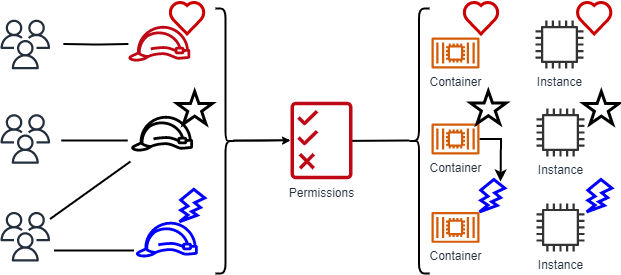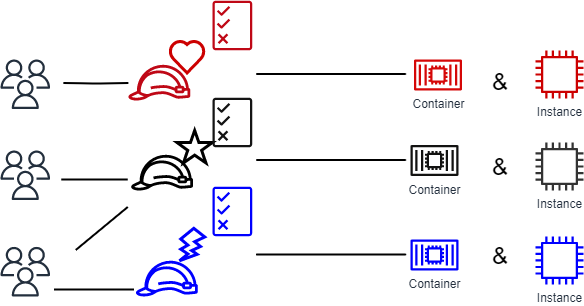What is ABAC for AWS?
Attribute-based access control (ABAC) is an authorization strategy that defines permissions based on attributes. In AWS, these attributes are called tags. You can attach tags to IAM resources, including IAM entities (users or roles) and to AWS resources. You can create a single ABAC policy or small set of policies for your IAM principals. These ABAC policies can be designed to allow operations when the principal's tag matches the resource tag. ABAC is helpful in environments that are growing rapidly and helps with situations where policy management becomes cumbersome.
For example, you can create three roles with the access-project tag key. Set
the tag value of the first role to Heart, the second to Star, and
the third to Lightning. You can then use a single policy that allows access when
the role and the resource are tagged with the same value for access-project. For
a detailed tutorial that demonstrates how to use ABAC in AWS, see IAM tutorial: Define permissions to
access AWS resources based on tags. To learn about services that
support ABAC, see AWS services that work with
IAM.

Comparing ABAC to the traditional RBAC model
The traditional authorization model used in IAM is called role-based access control (RBAC). RBAC defines permissions based on a person's job function, known outside of AWS as a role. Within AWS a role usually refers to an IAM role, which is an identity in IAM that you can assume. IAM does include managed policies for job functions that align permissions to a job function in an RBAC model.
In IAM, you implement RBAC by creating different policies for different job functions. You then attach the policies to identities (IAM users, groups of users, or IAM roles). As a best practice, you grant the minimum permissions necessary for the job function. This is known as granting least privilege. Do this by listing the specific resources that the job function can access. The disadvantage to using the traditional RBAC model is that when employees add new resources, you must update policies to allow access to those resources.
For example, assume that you have three projects, named Heart,
Star, and Lightning, on which your employees work. You create
an IAM role for each project. You then attach policies to each IAM role to define the
resources that anyone allowed to assume the role can access. If an employee changes jobs
within your company, you assign them to a different IAM role. People or programs can be
assigned to more than one role. However, the Star project might require
additional resources, such as a new Amazon EC2 container. In that case, you must update the
policy attached to the Star role to specify the new container resource.
Otherwise, Star project members aren't allowed to access the new
container.

ABAC provides the following advantages over the traditional RBAC model:
-
ABAC permissions scale with innovation. It's no longer necessary for an administrator to update existing policies to allow access to new resources. For example, assume that you designed your ABAC strategy with the
access-projecttag. A developer uses the role with theaccess-project=Hearttag. When people on theHeartproject need additional Amazon EC2 resources, the developer can create new Amazon EC2 instances with theaccess-project=Hearttag. Then anyone on theHeartproject can start and stop those instances because their tag values match. -
ABAC requires fewer policies. Because you don't have to create different policies for different job functions, you create fewer policies. Those policies are easier to manage.
-
Using ABAC, teams can change and grow quickly. This is because permissions for new resources are automatically granted based on attributes. For example, if your company already supports the
HeartandStarprojects using ABAC, it's easy to add a newLightningproject. An IAM administrator creates a new role with theaccess-project=Lightningtag. It's not necessary to change the policy to support a new project. Anyone that has permissions to assume the role can create and view instances tagged withaccess-project=Lightning. Additionally, a team member might move from theHeartproject to theLightningproject. The IAM administrator assigns the user to a different IAM role. It's not necessary to change the permissions policies. -
Granular permissions are possible using ABAC. When you create policies, it's a best practice to grant least privilege. Using traditional RBAC, you must write a policy that allows access to only specific resources. However, when you use ABAC, you can allow actions on all resources, but only if the resource tag matches the principal's tag.
-
Use employee attributes from your corporate directory with ABAC. You can configure your SAML or OIDC provider to pass session tags to AWS. When your employees federate into AWS, their attributes are applied to their resulting principal in AWS. You can then use ABAC to allow or deny permissions based on those attributes.
For a detailed tutorial that demonstrates how to use ABAC in AWS, see IAM tutorial: Define permissions to access AWS resources based on tags.